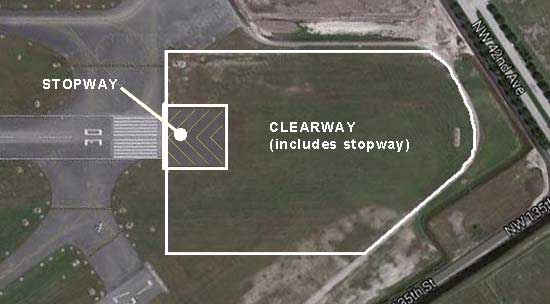

More and more airports are publishing cryptic numbers these days: TORA, TODA, ASDA, LDA. You can see tables of these in the Chart Supplement. On an instrument approach chart, you will see a reverse-color D on the planview, which alerts you to look for this information in the Chart Supplement. These are runway lengths, which aren't always the same for landing as they are for takeoff. Most discrepancies are explained by the presence of a displaced threshold, but there are two other fine points. First we need to define two terms, which are illustrated below for an airplane taking off from left to right.

Stopway. An area at the end of the runway that can support an aircraft that has rejected a takeoff. EMAS (crushable concrete) doesn't count.
Clearway. This is a larger area beyond the end of the runway that's free of obstacles, useful if you need a little extra room to clear that 50-foot tree.
Here's the relevant part of the directory entry, followed by an illustration. The length of the stopway or clearway could be zero, as for 9R/27L. This runway has no stopway or clearway at either end, and no displaced threshold. So all of its declared distances are the same.
LDA, Landing Distance Available. Threshold to threshold, not including displacement at the approach end.
TORA, Takeoff Run Available. Threshold to threshold, including displacements. This distance is all available for ground roll, if you're feeling lucky. Or precise.
ASDA, Accelerate-Stop Distance Available. Takeoff threshold to the end of the stopway, if it's there; threshold to threshold, if not.
TODA, Takeoff Distance Available. This is the total obstacle-free distance, including runway and clearway.